The Role of Life Vests in Kiteboarding: Safety First
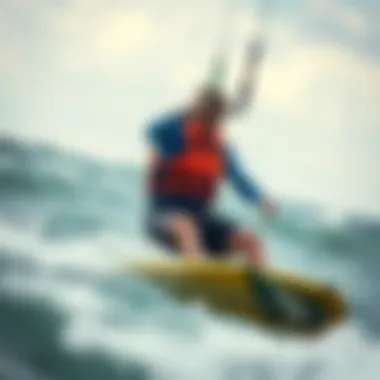
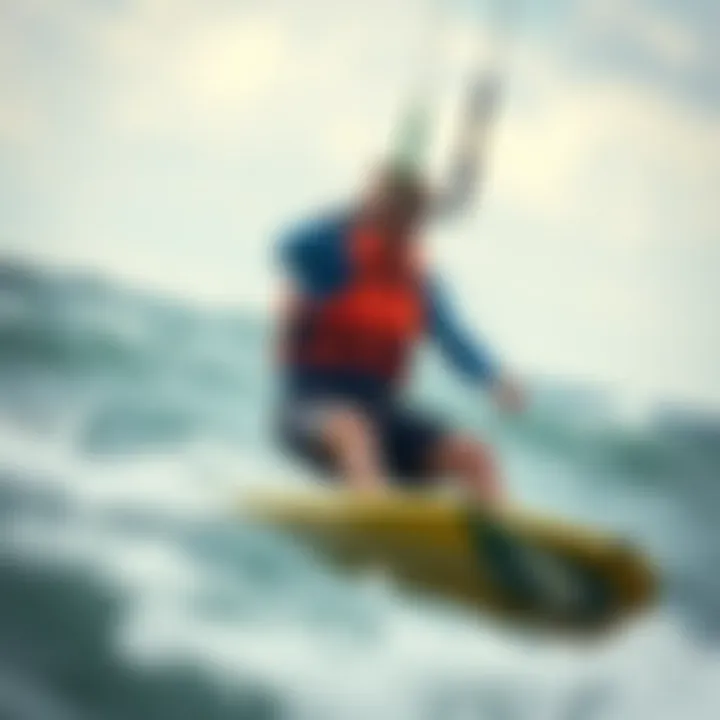
Intro
Kiteboarding is more than just a thrilling ride across the waves; it requires a delicate balance of skill, safety, and the right equipment. Central to this equation is the life vest, an often-overlooked piece of gear that can significantly influence both safety and performance on the water. A properly fitted and designed life vest not only keeps you afloat but also enhances mobility, allowing you to navigate tricky maneuvers with ease. In this article, we’ll delve into the vital role life vests play in kiteboarding, highlighting key features, the importance of maintenance, and how to choose the right vest to suit your style and needs.
Life vests have evolved significantly, with advancements in materials and technology, making it crucial to understand their impact on both safety and performance. Whether you're a beginner learning the ropes or a seasoned kiteboarder perfecting advanced tricks, your choice of life vest can make a world of difference. This section will provide a thorough breakdown of the various options available and how they can contribute to a safer, more enjoyable kiteboarding experience.
Foreword to Life Vests in Kiteboarding
Kiteboarding, a sport that blends thrill with skill, offers exhilarating moments while being close to nature. However, like any adventure that dips into the unpredictable waters, safety becomes a paramount concern. This is where life vests enter the conversation, serving not just as a safety net but as a critical component of the kiteboarding experience.
Life vests are specifically designed to keep a rider afloat, which is essential in a sport where the potential for falling into the water is high. They are more than mere flotation devices; they enhance comfort and performance on the water. The feeling of being secure uplifts a rider's confidence, allowing them to push boundaries, try new tricks, or simply enjoy the ride without the constant worry of safety.
Why are life vests so vital? Well, kiteboarding can involve high speeds and jumps. A sudden tumble can lead to unexpected situations, especially in rough waters. Here are some key points surrounding the role of life vests:
- Flotation Assurance: Life vests help keep riders above water. In the event of a fall, they make it easier to catch a breath before regaining composure.
- Impact Protection: Depending on the type of vest, many provide cushioning that can reduce the jarring impact on the body when hitting the water.
- Thermal Insulation: For those who prefer to kiteboard in cooler conditions, some vests can offer thermal benefits which can shield against chilling waters.
However, choosing the right life vest is not just about grabbing the first one off the shelf. It involves careful considerations surrounding fit, buoyancy, and the activities planned. A well-fitted vest not only feels comfortable but also doesn’t hinder a rider's movements. Consider the phrase, "a good life vest is like a second skin"—it should blend seamlessly into the experience, enhancing rather than limiting the range of motion.
Ultimately, the journey begins with understanding the impact of life vests in kiteboarding. As riders dive into the waves and soar through the air, knowledge about these essential devices can not only protect but also enhance their performance. As we delve deeper into this article, we’ll explore various aspects of life vests—history, types, features, and more—laying out a roadmap to informed decision-making for kiteboarding enthusiasts.
Historical Context of Safety Gear
Understanding the historical context of safety gear, particularly life vests, is pivotal in appreciating their role in kiteboarding today. With the evolution of water sports, there has always been an inherent risk involved, making the development of safety equipment not just a luxury but a necessity. Kiteboarding, with its thrilling reliance on wind and water, demands particular attention to safety measures that can protect practitioners from potential accidents.
Evolution of Life Vests
Life vests have undergone significant transformations since their inception. Early flotation devices were often rudimentary, made of cork or even simple sacks. As kiteboarding gained popularity, the need for specialized life vests became apparent. Designers and manufacturers began experimenting with materials and shapes to both enhance safety and improve the experience of the rider.
In the last two decades, life vests have shifted considerably with advancements in technology and materials. Today, you can find vests crafted from lightweight, buoyant foam combined with high-strength fabrics that are designed to be both comfortable and durable. These modern designs not just float but also offer superior impact resistance, making them an integral part of any kiteboarder's gear.
"Safety is not just a measure; it’s a mindset that has evolved with the sport."
Kiteboarding enthusiasts now have access to specific vests that fulfill diverse needs—whether for enhanced buoyancy during beginners' lessons or tailored for high-performance riders who demand mobility and reduced drag. There’s a life vest to fit the style and skill level of every kiteboarder.
Regulations and Safety Standards
Regulatory bodies have started recognizing the importance of safety gear in sports like kiteboarding. Over time, specific standards have emerged, dictating the minimum safety requirements for life vests. Organizations such as the U.S. Coast Guard and the International Kiteboarding Organization have set guidelines that influence both manufacturers and consumers.
Safety standards typically include specifications for buoyancy levels, material strength, and design features such as secure fastening mechanisms and visibility colors. By adhering to these standards, manufacturers ensure that their products not only comply with the law but genuinely offer protection against the unpredictable dangers of the water.
When selecting a life vest, it's critical to consider its compliance with these standards as it assures the user of its reliability. Furthermore, staying updated on evolving regulations can also aid kiteboarding enthusiasts in making informed choices that enhance their safety on the water.
In summary, the historical context of safety gear, with close attention to the evolution of life vests and the establishment of regulations, highlights the growing importance of safety in kiteboarding. Understanding where these developments stem from provides kiteboarders not only with insights on past advancements but also equips them with the knowledge to make better choices for their safety today.
Types of Life Vests
When it comes to kiteboarding, understanding the different types of life vests is crucial for both safety and performance. Each kind of vest serves myriad purposes tailored to specific needs. Choosing the right type can enhance your experience on the water by providing the appropriate level of support, reducing risks associated with accidents, and allowing for greater mobility. Below, we explore three principal categories of life vests: buoyancy aids, inflatable vests, and impact vests.
Buoyancy Aids
Buoyancy aids are often seen as the most basic form of safety gear in kiteboarding. They are designed to keep the user afloat in the water, primarily focusing on flotation without excessive bulkiness. These vests often have a slim fit which allows for unhindered movement while being lightweight.
- Key Features:
- Minimalist design for freedom of movement
- Typically made from foam for buoyancy
- May include adjustable straps for a snug fit
As kiteboarding demands a high degree of agility, buoyancy aids cater to this requirement. They do not hinder the rider’s movements, making them an attractive choice for many enthusiasts. However, it is essential to note that while their main function is to provide flotation, they may not offer substantial impact protection or additional features like storage pockets.
Inflatable Vests
Inflatable vests are a modern twist on traditional buoyancy aids, offering users the advantage of adjustable buoyancy. This type of vest includes a mechanism that allows for inflation when in water, which adds to the safety features without sacrificing mobility when on land.
- Key Features:
- Provides adjustable buoyancy for customized support
- Compact form until inflated
- Can be inflated manually or automatically upon submersion
Kiteboarders often appreciate the versatility of inflatable vests, particularly for longer sessions where space and weight become concerns. Just keep in mind that they require maintenance to ensure they function correctly, such as checking the inflation mechanism and replacing CO2 cartridges regularly.
Impact Vests
Impact vests focus more on protection against physical injuries that can occur in high-impact scenarios—such as hard landings or collisions. These vests feature additional padding and are generally designed to absorb shock, thus mitigating the risk of injury while kiteboarding.
- Key Features:
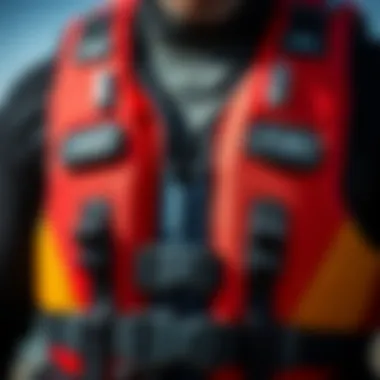
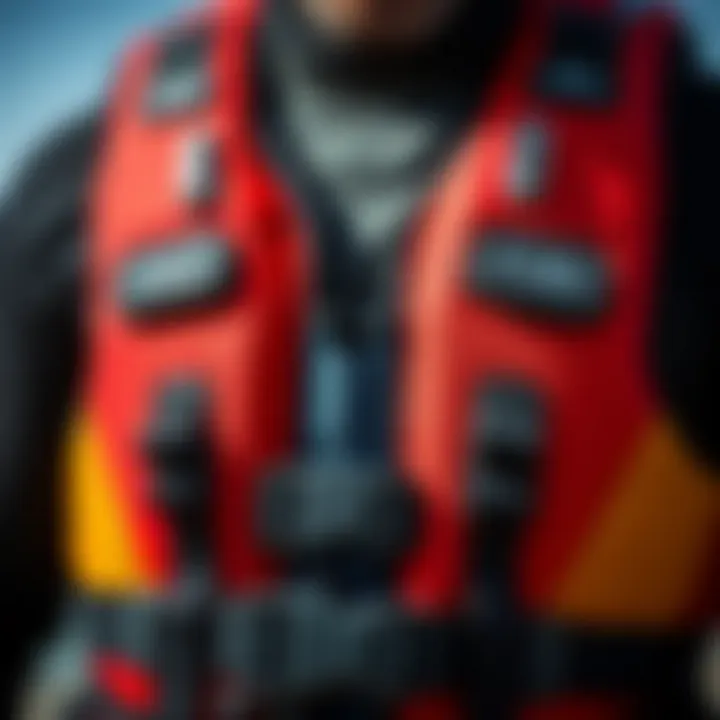
- Foam padding for increased impact absorption
- Often bulkier, sacrificing some mobility for protection
- May include harness systems for added safety and convenience
For riders pushing their limits or those engaging in more aggressive maneuvers, impact vests can be a lifeline, reducing the chances of injury without compromising on buoyancy. They ensure that, amidst the twists and turns while navigating the waves, safety does not take a backseat.
Features to Consider
When kiteboarding, choosing the right life vest transcends mere personal preference; it’s a matter of safety and performance. As thrilling as it may be to glide across the water, the unpredictable nature of the elements requires kiteboarders to equip themselves appropriately. Therefore, understanding the various features of life vests is paramount. Some key elements include material and construction, fit and adjustment mechanisms, along with storage and accessory features.
Material and Construction
The material of a life vest influences both its weight and durability. Options range from neoprene, known for its flexibility and warmth, to lightweight polyester, which offers breathability. However, it’s essential to look beyond just the feel of the material.
- Durability: The construction of the vest should be able to withstand repeated exposure to saltwater and UV rays, minimizing wear and tear. Look for reinforced stitching in critical areas; this often determines how long the vest can last during frequent use.
- Water Repellency:
This is a crucial feature – no one likes a soggy vest! Some materials dry quickly and resist water absorption, keeping riders light and agile on the board. - Comfort: The design should allow for ample movement, ensuring that the vest doesn’t become an impediment during tricks or turns. A vest that feels like a second skin can make all the difference in overall performance.
In many ways, the right material sets the groundwork for a positive kiteboarding experience.
Fit and Adjustment Mechanism
Having the right fit cannot be overstated. A vest that fits well provides not only comfort but also enhances safety. A loose life vest can shift or ride up when you crash, which might lead to discomfort or even hinder your safety.
- Sizing Guidelines:
It's advisable to refer to sizing charts provided by manufacturers when selecting a life vest. An appropriate size ensures effective buoyancy and optimal movement. - Adjustment Mechanisms: Modern life vests offer various adjustment features, such as side buckles, pull straps, and even Velcro patches. These allow users to tailor the fit according to their body shape and needs. An adjustable vest accommodates changes – like a thicker wetsuit during colder weather – without compromising safety.
"A life vest that's snugged up like a pair of well-tailored pants keeps both you and your performance under control."
Properly fitting vests boost confidence on the water and help riders focus on the ride rather than their gear.
Storage and Accessory Features
Lastly, think about additional features that can enhance the kiteboarding experience without cluttering it. Look for vests that come equipped with practical storage options.
- Pockets:
Vests with pockets allow riders to store essentials like sunscreen, small tools, or even a snack. Zippered pockets offer extra security, ensuring that your belongings stay put during a session. - Attachment Points: Some vests come with D-rings or loops for attaching items such as safety whistles or knives. These can be crucial in emergencies, providing quick access to important tools without needing to rummage through bags or pockets.
- Integrated Accessories: Nowadays, some brands are integrating features like hydration packs or even small buoyancy aids within the vest design. These innovations not only enhance practicality but also maximize the vest's efficiency for kiteboarding needs.
In sum, when selecting a life vest for kiteboarding, paying close attention to the features discussed above can dramatically improve one's experience on the water. Practicality lies at the core of a good life vest, merging safety with performance while making those moments out on the waves all the more rewarding.
Importance of Proper Fit
Finding the right fit for your life vest isn’t just a matter of comfort; it can mean the difference between safety and disaster while kiteboarding. A life vest that fits properly ensures that the vest remains secured on your body, regardless of the conditions you may encounter in the water. Loose vests can slide or shift, potentially exposing you to an increased risk of injury or making you less buoyant.
Furthermore, a snug fit enhances control over your kiteboarding maneuvers. When your vest fits well, you can move freely without any cumbersome distractions. This gives you the confidence to fully engage with the wind and water, instead of worrying about whether your vest will hold in place. In essence, a life vest that flatters your shape while enabling movement will optimize both safety and performance.
Ultimately, the importance of finding a life vest that fits well comes down to understanding your body and your riding style. You wouldn’t wear shoes a size too big or small, so why would you do the same with a life vest? When choosing the right vest, consider how it will behave during your rides, how it feels against your skin, and how it supports your movements.
Sizing Guidelines
When it comes to choosing the right size of life vest, there’s no one-size-fits-all. Each manufacturer may have different sizing systems and recommendations, so it's important to consult their specific guidelines. Generally, one should look for the following when assessing proper sizing for life vests:
- Measurement: Take your chest measurement as well as your waist measurement. This will give you a good starting point. Most brands have a sizing chart based on these measurements.
- Weight Range: Many life vests also have a weight range indicating the size suitable for the wearer. Make sure to cross-check your weight with the recommended range to ensure buoyancy.
- Age Category: Consider the age group for which the vest is intended. Vests designed for children may not fit adults properly, and vice versa.
A well-fitting life vest should feel snug but not restrictive. Signs that a vest may not fit correctly include:
- Excess fabric that bunches or folds when you move.
- Gaps between the vest and your body.
- Discomfort in your arm or shoulder movements at any point.
Testing for Comfort and Movement
The testing phase is crucial to ensure that your life vest doesn’t just fit but is comfortable for prolonged use in diverse conditions. Start by putting the vest on and moving your arms in various directions. It should allow you to lift your arms freely as you navigate your kiteboard and perform tricks.
- First Impressions: Stand up, crouch, and stretch. Does the vest ride up or shift around? Ideally, it should stay in place while allowing you to go through your range of motion.
- Water Interaction: If possible, do a test ride with your vest. Some companies even allow you to try out their vests in water before committing to a purchase. This real-world testing can be invaluable.
- Material Feel: Consider how the material feels against your skin. A great vest will use breathable materials that don't chafe or irritate you over time.
"The difference between a good ride and a great one can often come down to your level of comfort and freedom."
Investing time in choosing the right size and fit isn’t merely a preliminary task; it's foundational to your entire kiteboarding experience. With proper fitting gear, you not only ensure safety but further invest in your performance, giving you the confidence to push your limits out on the water.
Safety Considerations in Kiteboarding
Kiteboarding, while exhilarating, comes with its own set of risks that can turn a day of fun into a harrowing experience if safety isn't prioritized. This is where the importance of life vests truly shines. These buoyant companions play a crucial role in not just protecting riders but also in enhancing their overall experience on the water. By ensuring that life vests fit properly and cater to the kiter’s specific needs, riders can significantly mitigate risks associated with their thrilling sport.
Risk of Water-Related Incidents
Despite the adrenaline rush kiteboarding offers, the risk of water-related incidents is always present. The unpredictable nature of both the wind and water conditions means that even experienced kiteboarders can find themselves in precarious situations. Instances such as falling off the board, getting entangled in lines, or being knocked around by waves can occur rapidly. The water can be as unforgiving as it is beautiful.
It’s noteworthy that many professionals and enthusiasts have reported near-miss situations where a life vest made all the difference in returning to safety. Research indicates that drowning remains a top cause of fatalities in water sports, especially among those who do not wear appropriate safety gear. Having a life vest means adding an extra layer of security, allowing riders to stay afloat and breathe while help arrives or until they regain their composure.
"The best accident prevention is preparation. Be it tactics in the air or safety gear when you hit the waves, stay ahead of the game."
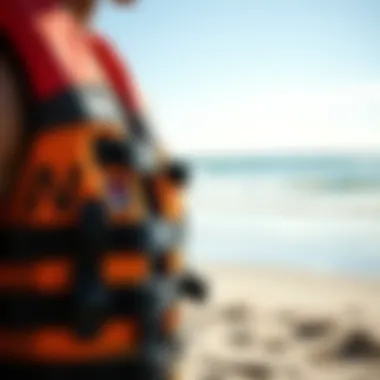
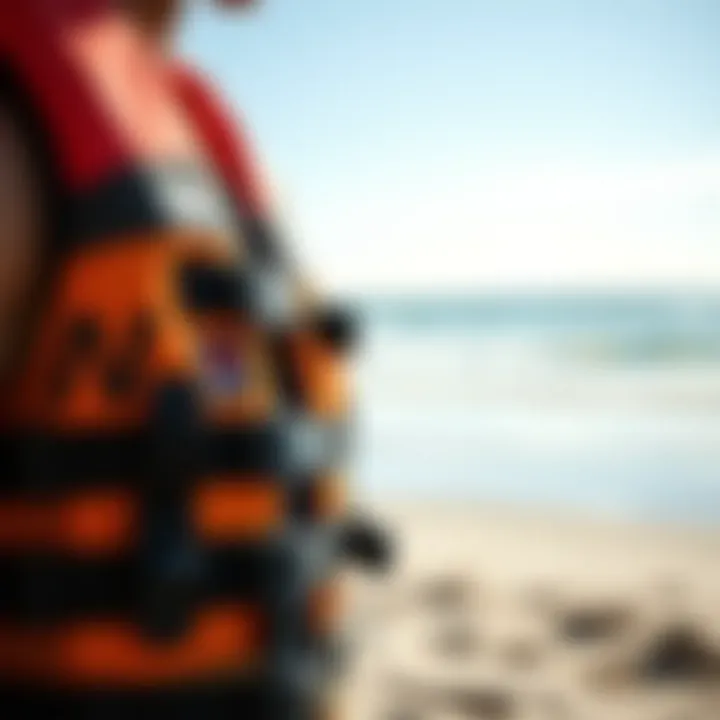
Furthermore, the water-related risks extend beyond just drowning. Hypothermia can set in quickly in cooler waters, making every second count. A well-fitted life vest can help maintain core body temperature while a rider regains control over their situation. In essence, the right life vest provides vital buoyancy that can be critical in emergencies.
The Role of Life Vests in Accident Prevention
The role of life vests in accident prevention can't be overstated. These essential gear pieces act like a safety net, catching riders before they fall too far. Think of a life vest as a handy insurance policy that you wear. It’s about being proactive rather than reactive. When the wind kicks up and conditions become rough, knowing you're secured in a life vest allows for clearer thinking and ability to focus on navigating
Life vests not only keep a rider afloat but also support vital safety measures as part of a holistic approach to kiteboarding safety. Properly designed life vests often include features such as reflective materials for visibility, which can be lifesaving in low-light conditions. They minimize the risk of entrapment by featuring quick-release mechanisms, allowing for rapid detachment if needed.
Consider this a short checklist for the role of life vests in accident prevention:
- Buoyancy: Crucial to keep the rider afloat.
- Visibility: Bright colors and reflective materials enhance detection in emergencies.
- Support: Good life vests help in stabilizing the body during unexpected falls.
- Detachment Option: Safety mechanisms that release quickly can prevent accidents while tangled.
Ultimately, the integration of life vests into the kiteboarding experience not only provides a crucial safety net but also fosters confidence among riders. Understanding their importance is the first step towards making informed choices that can enhance both safety and enjoyment on the open water.
Performance Implications
The significance of life vests in kiteboarding extends far beyond just safety. The right life vest enhances an individual's performance on the water, contributing to both mobility and comfort while minimizing the risks involved. As kiteboarding enthusiasts know, the dynamics between the rider, the kite, and the water create a unique set of challenges. A well-chosen life vest can significantly influence how a kiteboarder maneuvers and reacts to these challenges, ensuring that the experience remains both enjoyable and safe.
Among the most crucial aspects of performance implications are mobility and maneuverability, which directly affect the rider's ability to execute tricks and maintain control in various conditions. Furthermore, the impact resistance and comfort of the vest play a pivotal role in the overall experience. A life vest that does not fit properly or restricts movement can hinder the rider's performance and might even lead to situational dangers.
Mobility and Maneuverability
Mobility is the name of the game in kiteboarding. The sport thrives on quick movements and sharp turns, all of which require a full range of motion. A kiteboarder needs to be able to shift weight and adjust positioning fluidly to control the board and respond to the kite's movements effectively. This is where the design and fit of the life vest come into play.
A bulky or ill-fitting vest can impede a rider's ability to move freely, making it difficult to react to changing conditions or execute tricks flawlessly. Lightweight materials and streamlined designs are thus paramount. Vests made from neoprene or other flexible, durable fabrics provide snug fits that mold to the body's shape while allowing ample flexibility.
Additionally, features such as side adjustments using Velcro or quick-release buckles can cater to individual body types, ensuring that the vest remains secure without being restrictive. It’s not just about comfort; mobility enhances safety by enabling the rider to react promptly in emergency situations.
"A well-designed life vest can feel like a second skin, allowing the rider to fully engage with the water and wind."
Impact Resistance and Comfort
When kiteboarding, crashes are part of the deal. Therefore, the impact resistance of a life vest is crucial for minimizing injury risks during falls. A vest that incorporates foam padding or specialized impact-absorbing materials can help protect vital areas of the body during those unexpected tumbles. Such padding not only cushions blows but also provides buoyancy, aiding in flotation after a fall, which is essential for quick recovery.
In addition to safety, comfort cannot be overlooked. A vest that remains comfortable throughout a session can make a world of difference in performance. Muscles will fatigue more slowly if there’s no chafing or overheating. Many modern life vests come with ventilation systems or mesh panels designed to improve airflow, keeping riders cool during intense sessions.
A snug yet comfortable vest allows riders to focus on performance rather than constant adjustments. Regular checks on the condition of the vest also ensure that it retains its protective qualities. Proper care—like rinsing after every use and avoiding prolonged sun exposure—can prolong its life and functionality.
Ultimately, the goal is to find a balance between protection and performance. The right life vest aligns safety with the ability to perform optimally, ensuring that kiteboarders can enjoy their time on the water without the overhang of fear.
For more tips on choosing the right gear, check out detailed discussions on reddit.com/r/kiteboarding where avid enthusiasts share their firsthand experiences.
Moreover, consider resources such as britannica.com for background on water safety and performance basics that can help equip you for the best kiteboarding experience.
Maintenance of Life Vests
Taking care of life vests isn’t just a routine chore; it’s a vital practice that contributes to both safety and longevity in kiteboarding. A well-maintained vest can truly be a lifesaver, ensuring its buoyancy and performance remain intact over time. Without proper maintenance, a life vest might not function correctly when needed the most—it’s just like putting off oil changes for your car; eventually, it can lead to bigger problems.
Regular maintenance involves two main areas: cleaning and storage. Both are crucial for kiteboarders to not only extend the lifespan of their gear but also to ensure their safety during watersports activities.
Cleaning Procedures
Keeping your life vest clean is essential. After a day out on the water, your vest may accumulate dirt, sand, and salt. These can break down materials and lead to irritation when you wear it. To clean your vest:
- Rinse off immediately - After each session, rinse your vest with fresh water. This helps remove salt and grime that can harm the fabric and buoyancy materials.
- Use mild soap - If there's serious dirt buildup, mix a bit of gentle detergent in lukewarm water. Soak the vest for a bit, then scrub gently with a soft brush or cloth, focusing on any stained areas.
- Air Dry - Avoid direct sunlight for prolonged periods, as UV rays can weaken the fabric over time. Instead, lay it flat in a shaded area to dry thoroughly.
- Check for damage - While cleaning, inspect for rips, tears, or any signs of wear. Early detection can save you a lot of trouble later.
Remember, neglect can be costly. A small tear on the surface can become a huge problem if ignored.
Storage and Care Recommendations
Proper storage is equally important. How and where you keep your life vest can significantly affect its durability. Here are some tips to follow:
- Store in a cool, dry place - Heat and humidity can warp the materials, potentially compromising both buoyancy and comfort.
- Avoid folding - Always hang your vest instead of folding it. Folding can create creases that may weaken the structure of the vest. A multi-hanger can work wonders, keeping its shape intact.
- Consider a designated bag - If you have multiple boards or accessories, designate a bag just for your vest. This keeps it separate from stray things that could cause scrapes or, worse, punctures.
- Utilize a garment bag - For multi-season gear, store the vest in a breathable garment bag to protect it from dust and pests while allowing air circulation.
Emerging Technologies in Life Jackets
In the fast-evolving landscape of kiteboarding, the emergence of cutting-edge technologies in life jackets has ushered in significant enhancements in safety and performance. As kiteboarding continues to gain traction, understanding these new advancements becomes crucial for riders who want to maximize their safety and experience on the water.
Among the most compelling elements within this theme is the integration of high-tech solutions designed to monitor and enhance rider safety. These innovations are not simply novelties; they can mean the difference between a scare and a serious incident on the water. With features such as built-in GPS tracking, automatic inflation, and real-time health monitoring, smart vests are setting a new standard for safety gear, helping riders feel secure while pursuing the adrenaline-filled excitement that kiteboarding offers.
Smart Vests with Safety Features
Smart vests stand at the forefront of these advancements, encapsulating a myriad of safety features that provide an extra layer of reassurance for kiteboarders. For example, some models incorporate sensors that track heart rate and body temperature, alerting users if they are entering dangerous thresholds. Moreover, the built-in GPS capability allows for location sharing, crucial in emergency situations when every second counts.
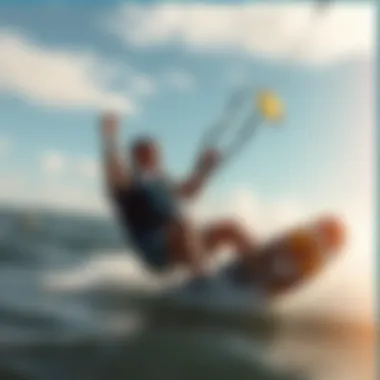
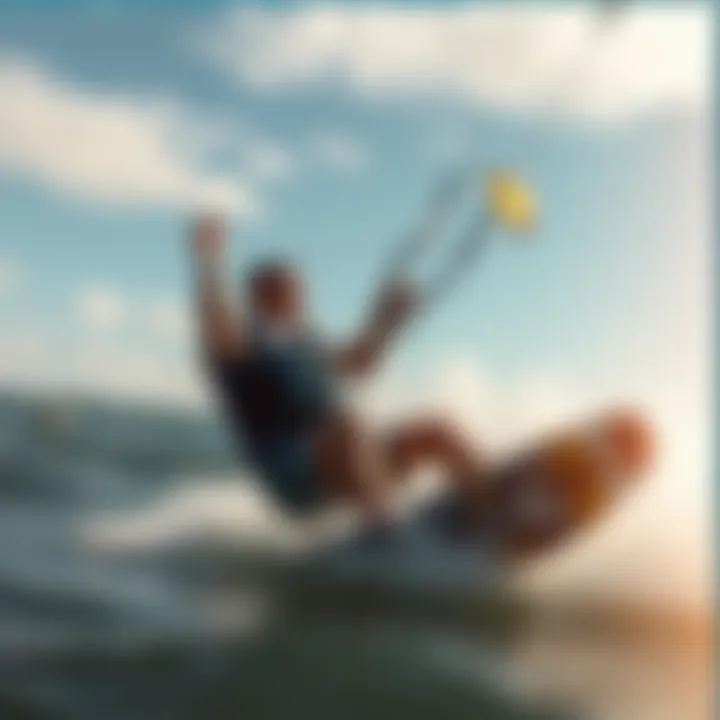
"Smart vests are not just gear, they're lifelines."
The design of these vests focuses on comfort, maintaining the flexibility needed for maneuverability while surfing the waves. Many smart vests are lightweight and ergonomically designed, enabling riders to perform without being weighed down or restricted. With a reliable wireless connection to smartphones, riders can stay informed about environmental conditions, making smarter decisions on when and where to ride.
The price point of these vests can range significantly, but the peace of mind they provide often outweighs the initial investment. For kiteboarders looking to enhance their safety while on the water, opting for smart vests should be a top consideration.
Sustainability in Materials
As awareness about environmental impact grows, the materials used in life jackets are undergoing a transformation. Many manufacturers are now focusing on sustainability, creating products from recycled or eco-friendly materials. This shift addresses not only the need for safety but also the responsibility to safeguard the environments that kiteboarders enjoy.
Benefits of using sustainable materials include durability and the reduction of harmful waste in oceans. Vests crafted from these eco-conscious materials often offer high levels of buoyancy while ensuring that they do not burden the environment.
Furthermore, advancements in material science are contributing to lighter and stronger fabrics, which improve overall performance. Riders can experience greater agility without sacrificing the protective qualities essential for safety. As kiteboarders increasingly prioritize sustainable practices in their sports gear, the rapid adoption of these materials is likely to catalyze further innovations, pushing the industry toward greener alternatives.
In summary, emerging technologies in life jackets, especially smart vests with safety features and the shift towards sustainable materials, are integral to the kiteboarding experience. These advances not only enhance safety and comfort but also align with a broader movement to protect the environment, ensuring that future generations can continue to enjoy this exhilarating sport.
Comparative Analysis of Popular Brands
When it comes to kiteboarding, the safety gear one chooses can significantly influence both performance and security on the water. This segment presents a comparative analysis of popular brands in the life vest market, helping enthusiasts navigate through the vast options available. With various specifications, prices, and features to consider, understanding these aspects can lead to informed decisions. Ultimately, kiteboarders must find a balance between comfort and protection—traits that differ across brands. Here, we delve into three specific brands to highlight their offerings.
Brand A: Features and Customer Feedback
Brand A has carved out a niche in the kiteboarding community with its focus on durability and comfort. One key feature is its adjustable straps designed for a secure fit, suitable for both casual riders and serious competitors. The materials used are lightweight yet sturdy, allowing for extended use without feeling bogged down.
In terms of customer feedback, many users rave about the vest’s breathability. One kiteboarder noted, "I’ve tried my fair share of vests, but Brand A’s design feels like a second skin!" This sentiment is echoed across various forums, indicating that Brand A has effectively combined comfort with performance. On the flip side, few have pointed out that it can take a little time to find the right size, which underscores the need for trying it on before purchase.
Brand B: Performance and Value
Brand B is often recognized for offering a great balance between performance and cost-efficiency. Built with a focus on safety without compromising on mobility, this brand utilizes advanced foam technology to ensure buoyancy while maintaining a sleek profile. The sleek profile not only aids in performance but also appeals visually to many riders.
Customers frequently highlight the vest’s quick-drying capabilities, perfect for those who may hop in and out of the water throughout the day. An avid kiteboarder affirms, "You get a lot of bang for your buck with Brand B—most value options just don’t measure up!" Additionally, its price point makes it accessible for both beginners and seasoned kiters looking to invest wisely. That said, some users have raised concerns about longevity, pointing out that repeated use may lead to some wear and tear.
Brand C: Innovative Designs
Brand C is synonymous with innovation in life vest design, often pushing the envelope with features that enhance both safety and aesthetics. One standout aspect is the incorporation of reflective strips, which improve visibility during low-light conditions. This design consideration is critical during early morning or twilight sessions when accidents are more likely to occur.
Customers appreciate the range of customizable options available, allowing riders to personalize their vests according to their style and preferences. A testimonial from a dedicated kiteboarder states, "Each ride feels more secure knowing that I stand out in the water!" However, it’s worth noting that some users mention the price tends to be on the higher side, which could deter budget-conscious buyers. Still, the blend of safety features and style makes Brand C a popular option among fashion-forward kiteboarders.
"Choosing the right life vest goes beyond just fit; it’s about aligning with a brand that shares your safety and performance values."
By analyzing these brands, kiteboarders can better understand the landscape of available life vests. This informed perspective can be crucial when selecting a product that aligns with personal needs and riding styles.
User Experiences and Testimonials
In the realm of kiteboarding, safety gear often gets overlooked in the thrill of the sport. However, understanding user experiences with life vests sheds light on their practical effects on both safety and performance. Testimonials provide real-world insights into how these devices function under pressure and whether they truly enhance the kiteboarding experience.
By listening to the voices of fellow enthusiasts, one can gauge not just how well a life vest fits into their activity, but also how it might affect their prowess on the water. When testing various vests, many kiteboarders find themselves sharing stories about the difference a well-constructed life vest can make during a session, often reflecting on aspects like comfort, mobility, and peace of mind while navigating the waves.
Beginner Perspectives
From the vantage point of novices, the significance of life vests is often realized through trial and error. New kiteboarders might start with the seldom-thought-about designs that, while offering basic buoyancy, may fall short when it comes to comfort or ergonomics.
For example, a beginner might recount their initial experience with a bulky vest that restricted movement, stifling their confidence as they attempted to learn. Such stories play a crucial role in stressing the importance of selecting a vest that allows for uninhibited movement while providing essential safety features.
- Comfort and Mobility: Many beginners note that a life vest that fits well and provides ample room for movement makes a world of difference.
- Trust and Confidence: When users hear stories of how a reliable vest enabled seasoned riders to perform tricks they never thought possible, it resonates deeply. Good vests create trust that allows newcomers to embrace challenges with more zeal.
Advanced Rider Insights
For experienced kiteboarders, the conversation around life vests often shifts toward precision and performance enhancement. Advanced riders are generally more discerning about the gear they choose—favoring vests that not only safeguard but also aid in performance. A skilled kiteboarder might share their thoughts on the advantages of streamlined designs that minimize drag without sacrificing buoyancy.
- Performance-Driven Design: Insights from advanced users often highlight features such as lightweight materials, quick-draining fabrics, and adjustable straps that come into play when navigating strong winds and turbulent waters.
- Personalized Comfort: Commitment to fit becomes paramount; as riders often emphasize the necessity of testing various styles before settling on one, ensuring it adheres well, allowing ample movement while remaining snug enough for safety.
Real experiences and testimonials bridge the gap between mere specifications and actual, tangible benefits. They allow both newcomers and seasoned kiteboarders to make informed choices based not just on advertising, but also on peer recommendations that emphasize the critical role life vests play in both safety and performance.
The End and Recommendations
In wrapping up our discussion, it's vital to reflect on the central theme of this exploration: the role of life vests in kiteboarding. These devices aren't just accessories; they embody safety, confidence, and a seamless connection to the water. When kiteboarding, the unpredictability of the ocean combined with the power of the wind can create a scenario where safety gear becomes not just crucial but lifesaving.
Ensuring that you choose the right life vest goes beyond mere aesthetics or brand trends. A lot is at stake when you're out there, navigating your kite in gusty winds or rough waters. A good fit, optimal material, and the vest’s features can significantly influence both safety and performance.
Summary of Key Points
- Significant Safety Impact: Life vests are designed to keep you afloat, reducing the risk of drowning and enhancing flotation. This is paramount in a sport characterized by rapid changes in conditions.
- Performance Considerations: The right vest doesn’t just keep you safe; it also allows for better movement and comfort. Kiteboarding requires freedom of movement, and a poorly fitted vest can hinder performance.
- Maintenance for Longevity: Proper care, including cleaning and storing your life vest correctly, can prolong its lifespan. A well-maintained vest can be your ticket to more enjoyable days on the water.
- Emerging Technologies: Keep an eye on advancements in safety gear technology. Smart vests with integrated safety features are becoming increasingly popular and could add an extra layer of protection.
Final Thoughts on Safety Gear
With all that's been said, investing in a quality life vest is one of the most responsible decisions you can make as a kiteboarder. Whether you are a novice or a seasoned pro, acknowledging the importance of safety gear can alter your overall experience on the water. It's not just about catching waves; it’s about ensuring that your adventures are memorable for all the right reasons. Remember, the ocean is mighty, and being well-prepared is half the ride.
As you gear up for your next kiteboarding excursion, take time to assess your life vest. Is it the right fit? Is it holding up well? Are you familiar with the latest features? Make sure you're answering these questions. After all, your safety is no laughing matter. Stay smart, stay safe, and most importantly, enjoy the wind beneath your kite.







